


| Kley was the inspiration for His color work is in 1, 3 & 8 and in the InkSpot in 12 |
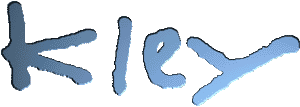 |
He's also in #1 |
I really like Heinrich Kley's art. What little reference I can find on him is an introduction to a 1968 Borden book titled The Drawings of Heinrich Kley. This is part of their Master Draughtsman Series and not to be confused with the Dover book of the same title. The introduction is by Donald Weeks and what follows is copyright by him and Borden Publishing Company.
I promise not to do this very often (using someone else's words here), but getting a new catalog out and recovering from pneumonia have sapped some of my will to write. Seeing as how I would just be paraphrasing much of Mr. Weeks words, I thought I'd do it right and let him speak for himself. Graphic presentation by yours truly.
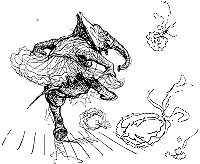
|
HEINRICH KLEY
|

|
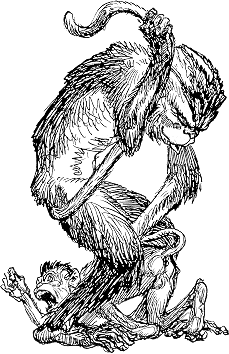 The
answer to "what is art?" is a very personal one. Paintings
and artists fall into many categories and, as people, no two are
alike. Yet the main function of any artist, in any art form, is
to communicate. And when it comes, artistically, to the technical
form of graphic art, the artist is at his best as a draftsman.
The greater the draftsman, the more the artist can suggest with
the least number of pen strokes. He knows beforehand where each
line will touch the paper and why. Each line and dot will convey
large areas of figure or scene, and the true artist/draftsman
can relate his imagination to the viewer. Add to this one other
quality the rare attribute of satirical humor and you have one
of the greatest draftsman of this century: Heinrich Kley.
The
answer to "what is art?" is a very personal one. Paintings
and artists fall into many categories and, as people, no two are
alike. Yet the main function of any artist, in any art form, is
to communicate. And when it comes, artistically, to the technical
form of graphic art, the artist is at his best as a draftsman.
The greater the draftsman, the more the artist can suggest with
the least number of pen strokes. He knows beforehand where each
line will touch the paper and why. Each line and dot will convey
large areas of figure or scene, and the true artist/draftsman
can relate his imagination to the viewer. Add to this one other
quality the rare attribute of satirical humor and you have one
of the greatest draftsman of this century: Heinrich Kley.
Heinrich Kley was first introduced to the American audience by the then new Coronet Magazine in three consecutive issues in 1937. A few of his satirical line drawings were reproduced. In its introduction to Kley, Coronet said that he had "died in a mad house a few years back." In 1937 Kley still had eight years to live, and he had never been in a mental institution.
Kley was born April 15, 1863, at Karlsruhe, Germany, and there
studied art at the Karlsruhe Akademy under Ferdinand Keller for
five years beginning in 1880, then continuing under C. Frithjof
Smith in Munich. He did his first small illustration work in Karlsruhe,
turning to painting, doing landscapes, interiors, portraits and
still life subjects. Between 1888 and 1894 he sent paintings to
exhibitions at the Munich Glasspalace and Sezession. During the
same time he created two murals, "Einweihung des roemischen
Merkuraltares" and "Spazierfahrt Kaiser Wilhelms I,"
for the main hall of the Reichspostgebaeude in Baden Baden.
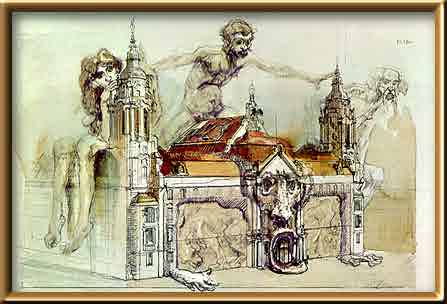
With the turn of the century, Kley changed his material and approach to art subjects using the matter of modern industrial life. The very special appeal this held for him can be seen in his work of that period. Blast furnaces, tunnel construction, ship docks, huge construction scaffolds and machine filled factory interiors took shape in his oils, water colors and drawings. And each picture showed the most careful observation of all the technical detail. Perhaps the best known of that period of Kley's works is "Tiegelstahlguss bei Krupp". He did architectural paintings of building exteriors in Old Munich, Nuremberg, Bruchsal, Dresden, the harbor of Kiel, Paris, Ostende, and the picturesque island of Helgoland in the North Sea. In 1903 he contributed a painting, "Darstellung des Heidelberger 'Sommertagzuges'," for part of the decoration of the new Town Hall in Karlsruhe. In 1908 he moved to Munich, and at the same time he began to limit himself almost entirely to pen line drawing. Those capricious drawings with their sarcastic content were published mostly in Simplicissimus and Jugend and brought Kley immediate fame.
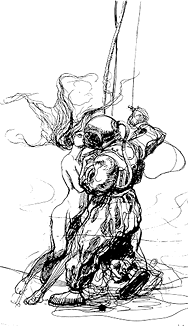 |
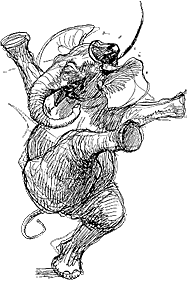
|
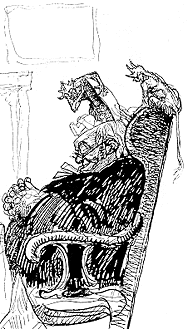 |
Book illustration began for him in 1886 with a single page (204" x 6" and folded) illustrated album, "Jubilaeum der Universitaet" Heidelberg. Drawn when he was 23, it is reminiscent of Beardsley in its scope at an early age. This book shows a single historic procession passing through Heidelberg, from "Gruendung der Universitaet durch Kurfuerst Ruprecht I" in 1386 to "Wiederherstellung fer Universitaet durch Karl Friedrich von Baden" in 1803. And at that age the illustration shows the beginning of the mastery of drawing animals. Besides collections of his periodical art,"Die Reiseschatten", "Vergils Aeneis Hetaerenbriefe", Der "Herr der Luefte" and "Streifzuege eines Kreuzvergnuegten" are books carrying his illustrations, showing the verve and masterful line technique in portraying fact and fantasy.
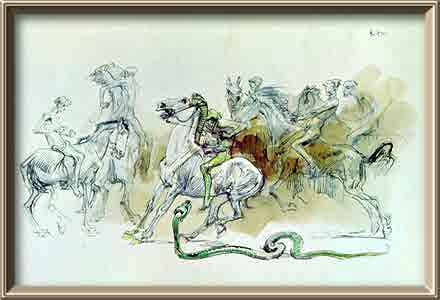
By the 1920s Kley had gone into commercial art. The Heinrich Kley of the satirical line drawings lived hardly more than a decade. But his work was prolific and skilled. During that short period of time, Kley himself was silent. He let his art speak for him, using his inward and fertile imagination. His work touched all people; it was amusing, but it did not stop there. He preached two lessons: the inanities of mankind and the touch of a true draftsman.
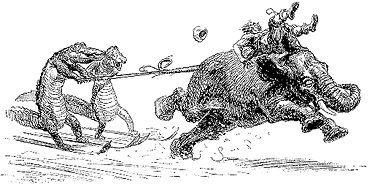
For almost thirty years Kley's work has been known by some people in this country. The humanized animals of Kley's pen can be seen in Walt Disney's "The Dance of the Hours" sequence from Fantasia. His work as pieces of individual art have been sought by the appreciative few. Much more recently his drawings have been incorporated into paperback cover designs, notably for Bantam Books. His drawings have been used as illustrations in magazines. Atlas and Motive are but two. The Fillmore Auditorium of San Francisco used his art in a poster. Kley's art is known. Yet Kley the man is not known.
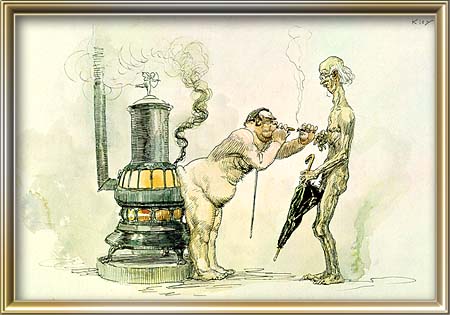
|
About 1920 the scene changed for him and he again changed his approach to art and subject matter and, in doing so, faded from the limelight of a specialized type of work into commercial art. He lived in Munich during two world wars. Many questions can be asked about his personal life. But what would be the answers? Let only his art - his line drawing depicting the wit, humor, satire, imagination of an all knowing artist speak for him. His line drawings show a clearness that is rare in the art of craftsmanship. Even though the actual social and historical background of his drawings is lost to us today, they themselves are just as rare and as humorous. The timeless art of Heinrich Kley lives. DONALD WEEKS |
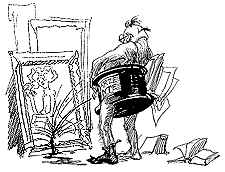
|
|
Original Publisher's Note: The Publisher wishes to acknowledge with deepest appreciation the assistance of Mr. Joe Grant, Mr. Donald Weeks, Mr. Richard Holt and the Staatliche Graphische Sammlung of Munich, Germany in helping to compile this volume. |
The Art Critic |
You knew I wasn't going to leave without saying something, didn't you? I mention Kley in my Albert Hurter page because I firmly believe that it was Hurter who introduced the Disney staff to Kley's work. There were two German compilations of his work, Skizzenbuch I & II in 1909 and 1910 from Albert Langen. If he started this phase of his career in 1908, he was definitely an immediate success. Other Langen collections were done in 1912 (Leut' und Viecher) and 1920 (Sammel-Album). The contents of all four of these books were gathered in 1961 into two marvelous Dover titles: The Drawings of Heinrich Kley and More Drawings of Heinrich Kley. All the art here is from his satirical period, as I have nothing else to draw upon. The illustrations on this page were take from those two Dover books and Borden's The Drawings of Kley, which is the only source that I know of for his color work and a remarkably difficult book to find. To confuse matters even more, Borden also published a two-volume set of Kley's work in 1941 & 1947 (there was this war that happened, remember?), also called The Drawings of Heinrich Kley 1 & 2. These are a lot easier to find than the 1968 book. Weird, huh?
See you in two weeks and I promise I'll do my own writing.
12/14/2005 update: Kley made his living with his paintings of industrial machinery. See ImageS #8 for an extensive feature on this “unknown” aspect of his career. The pen & ink drawings for which he is most famous were done for his own enjoyment as a reprieve from the machines. Kley died in Munich in 1945.
Thanks to Axel Schuessler for the new information.His industrial art is featured prominently is ImageS 8.
 To learn more about Heinrich Kley, see:
To learn more about Heinrich Kley, see:| The Drawings of Heinrich Kley | Intro. by Donald Weeks, 1968 Borden |
| The Vadeboncoeur Collection of Knowledge | Jim Vadeboncoeur, Jr. 1999 |
| The Vadeboncoeur Collection of ImageS 1, 3, 8, 12, B&W 1 | Jim Vadeboncoeur, Jr. 2001, 2002, 2008, 2010 JVJ Publishing |
| Illustrations are copyright by their respective owners. The essay, "Heinrich Kley 1863-1945" is © 1968 by Donald Weeks and Borden Publishing Co. The rest of this page written, designed & © 1999 by Jim Vadeboncoeur, Jr. Updated 2005, 2011. |
